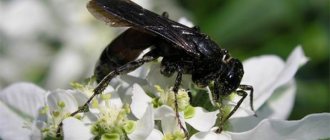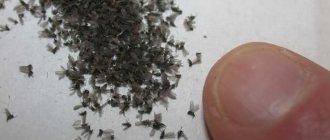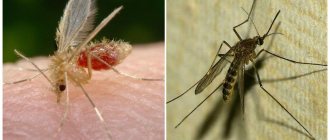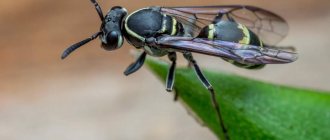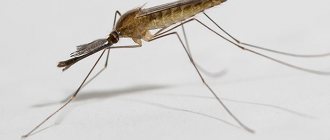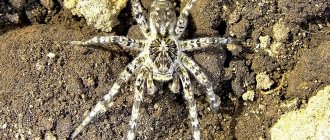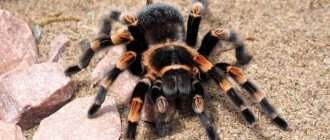- Wild animals
- >>
- Arachnids
Some people shudder at one photo of this creature, while others keep it at home as a pet. The species is one of the most famous venomous spiders. They are often confused with tarantulas, which is wrong, because the tarantula spider is much smaller. Despite popular belief, the creature's venom is not fatal to humans.
Description, structure, characteristics
Tarantula belongs to the phylum of arthropods, class of arachnids, order of spiders, family of spiders -
wolves are the genus of tarantulas themselves. Like many arthropods, the body of the tarantula is covered with small hairs. In general, the tarantula’s body structure has two main parts: the cephalothorax and abdomen.
At the top of the tarantula's head there are as many as eight eyes, with 4 of them located in a straight line, and the remaining larger eyes located in a trapezoid. Thanks to this arrangement of the eyes, tarantulas have a viewing angle of 360 degrees. Also, in addition to well-developed vision, these spiders also have an excellent sense of smell, with which they can sense potential prey at a considerable distance (for these insects).
The size of the tarantula varies from 2.5 to 10 cm. The span of the legs of this spider can reach 30 cm. Like many insects in the world, female tarantulas are usually several times larger than males.
Throughout their lives, tarantulas change the peculiar chitinous “armor” that covers their body several times. The tarantula also has four pairs of long, hairy legs, allowing the spider to move comfortably across loose or even water surfaces.
The mandibles of the tarantula are covered with poisonous canals, they are very strong and serve the spider as a means of defense and attack.
The color of the tarantula is usually brown, gray or black. Although sometimes there are representatives of these spiders that have lighter colors.
Natural enemies of tarantula spiders
Photo: Black tarantula spider
The tarantula has quite a few enemies. The main culprits in the death of arthropods are birds, since they are part of the diet of birds. Wasps encroach on the life of arachnids, just as spiders do with their victims. They inject poison into the tarantula's body, paralyzing the predator.
They then lay eggs inside the spider. Parasites live and develop, after which they get out. Natural enemies include some types of ants and mantises, which are not at all picky about food and eat everything that moves. Frogs and lizards are not averse to eating tarantulas.
The most dangerous enemy is still the same spider. Arthropods tend to eat each other. A female, during the process of fertilization, can encroach on the life of a male individual, like a female praying mantis, or eat her offspring if she cannot trap some insect.
There is continuous hostility between tarantulas and mole crickets. Their habitats overlap. Mole crickets dig the soil, where spiders often climb. Sometimes individuals manage to escape. Wounded or molting arthropods usually become food for the enemy.
In general, the population suffers most in early spring. When lethargic and sleepy arachnids crawl out of their shelters, the mole cricket is right there. Sometimes they climb into spider holes and attack tarantulas with their forelimbs, delivering heavy blows. When the spider loses a lot of blood, the mole cricket eats it.
Difference from tarantula
Tarantulas are often confused with the tarantula spider, so to put an end to this, here are the differences between them:
What does a tarantula look like, are they present in Russia, and how dangerous are they?
Tarantulas are poisonous animals, class arachnids, poisonous arthropods. Its appearance can hardly be called pleasant, but many people keep them as exotic pets. The name comes from Italy; during the Renaissance, a large number of spiders were found in the country. After being bitten, people could suffer from seizures.
The largest number of bites was recorded in Taranto, a city in Italy. This is where the name of this arthropod species comes from.
It is also noteworthy that medieval doctors, in order to recover from the consequences of a bite, recommended that the patient perform a special dance called the tarantella for a long time. The name of this dance is closely related to both the city where there were many of them, and the very name of the animal.
Below we will look at all the facts about tarantulas: what they eat, structure, methods of reproduction and other interesting information.
Nutrition
As you probably already guessed, tarantulas are notorious predators, their food consists of numerous small insects and amphibians: caterpillars, mole crickets,
crickets, beetles, cockroaches, small frogs, etc. Tarantulas watch their prey from a hiding place and then quickly attack. Having attacked, they paralyze the prey with their poison, which subsequently turns its insides into a nutritious liquid, then the tarantula sucks it out like a “cocktail”.
The process of absorption of food by a tarantula can last several days, but in general they are not very voracious and can do without food for a long time, as long as they have access to water.
Types, photos and names
There are about 200 species of tarantulas, but we will describe the most interesting of them.
Apulian tarantula
He is a real tarantula, lives in the south of Europe, including Italy (most likely it was he who gave the name to the entire species of these spiders) and also in North Africa. It is approximately 7 cm in length. Also, unlike other species of tarantula, it does not spin webs.
South Russian tarantula or Mizgir
As the name suggests, this tarantula lives in the south of Russia, Belarus, as well as our country Ukraine, in the countries of Central Asia. This species of tarantula is small, rarely exceeding 35 mm in size. A characteristic feature of this type of tarantula is the presence of a special dark cap. With the onset of cold weather, these tarantulas burrow deep into their burrows, where they successfully winter, and with the onset of spring they come to the surface.
Spanish tarantula
This tarantula also lives in southern Europe, particularly Spain, Italy, Portugal, and North Africa. It was once considered a subspecies of the Apulian tarantula, but was later classified as a separate species.
Brazilian tarantula
This type of dark brown tarantula lives in the tropical forests of South America, Brazil, Paraguay, and is found in many other South American countries. A characteristic feature of this tarantula is the presence on its head of a light longitudinal stripe of a yellowish tint.
Where does the tarantula spider live?
Photo: Tarantula spider from the Red Book
The habitats of the species are represented by a wide range - the southern part of Eurasia, North Africa, Australia, Central and Asia Minor, America. Representatives of the genus can be found in Russia, Portugal, Italy, Ukraine, Spain, Austria, Mongolia, Romania, and Greece. Arthropods choose arid areas to live.
They live mainly in:
- deserts;
- steppes;
- semi-deserts;
- forest-steppes;
- gardens;
- vegetable gardens;
- on the fields;
- meadows;
- along the banks of rivers.
Tarantulas are heat-loving arachnids, so they cannot be found in cold northern latitudes. Individuals are not particularly picky about their habitats, so they even live in saline steppes. Some manage to get into houses. Distributed in Turkmenistan, the Caucasus, Southwestern Siberia, and Crimea.
Most predatory spiders prefer to live in burrows that they dig themselves. They choose the location for their future home very carefully. The depth of vertical burrows can reach 60 centimeters. They move the pebbles to the side and rake out the soil with their paws. The walls of the tarantula's shelter are covered with cobwebs. It vibrates and allows you to assess the situation outside.
At the end of autumn, spiders prepare for wintering and deepen their homes to a depth of 1 meter. The entrance to the hole is plugged with leaves and branches. In the spring, animals crawl out of the house and drag the web behind them. If it suddenly breaks, there is a high probability that the animal will no longer find its shelter and will have to dig a new hole.
Now you know where the tarantula spider lives. Let's see what the poisonous spider eats.
Reproduction
The mating season for many species of tarantulas occurs in late summer. A sexually mature male weaves a web, then begins to rub his abdomen against it. As a result of this, he ejaculates seminal fluid, which ends up on the web. The male then plunges his pedipalps into it, which absorb it and become ready for fertilization.
And only then does the search for the female begin. Having found his “lady,” the male begins courtship, which includes performing a kind of courtship dance. If the female reciprocates the “gentleman’s feelings,” he plunges his pedipalps into her cloaca and fertilizes her. Then it is very advisable for the male to quickly leave his “lady” so as not to become dinner for her, as happens with
Praying mantis of some other insects.
Then the baton of prolongation of the genus passes to the female, she begins to weave a special cocoon where she lays her eggs; there are usually from 50 to 2000 eggs per clutch.
The eggs mature within 40-50 days, and small tarantulas hatch from them, which begin to grow rapidly, and by 2-3 years have already reached sexual maturity.
Lifestyle
The tarantula digs burrows mainly on mountain slopes. Burrows are up to 50-60 centimeters deep. The entrance to them is bordered by a small ridge consisting of dry leaves. During the day, the tarantula usually sits in a hole, and at night it goes for prey, which consists of various insects. In winter, the tarantula clogs its home with dry plants intertwined with cobwebs. Young spiders (up to 300 pieces) emerge from the facial cocoon and stay on the mother’s body for some time.
In Russia, the most common type of tarantula is the Mizgir (Latin name Lycosa singoriensis). Its color is very variable and can be black-brown, light brown, or reddish with various spots. It has been noticed that the color is largely adapted to the surrounding environment, mainly the color of the soil.
Bite and effect of poison on humans
The tarantula itself is unlikely to attack a person. But he can be forced to do this by the actions of the person himself, for example, if he accidentally touches a spider, the latter may bite in self-defense.
A tarantula bite is not dangerous for a healthy person, with the exception of children and people with allergic reactions, in such cases it is imperative to seek professional medical help.
Symptoms of a tarantula bite and their consequences may look like this:
- local pain at the site of the bite, redness and swelling.
- drowsiness, lethargy, general poor health.
- a sharp but short-term increase in temperature.
- in some cases there may be nausea and vomiting.
Interesting Facts
- There is no exact information about the etymology of the name of this genus of spiders. However, most researchers believe that its origins go back to the Renaissance. Then, many convulsive seizures that occur in humans were associated with spider bites, which lived in large numbers in the vicinity of Italian cities, including in the city of Taranto in southern Italy, where the largest number of bites was noted. It was thanks to this city that the spiders got their name. It is noteworthy that to cure a disease, medieval doctors prescribed dancing a special dance to exhaustion - the tarantella.
- The tarantula is literally tied to its hole. When a spider crawls out of its home, a web trails behind it. And if the web suddenly breaks, the tarantula often loses coordination and is unable to find its hole. In this case, the spider digs a new home for itself.
- The tarantula's blood contains an antidote to its poison. Therefore, when bitten, if possible, it is necessary to knead the spider and lubricate the bite site with its blood.
- Tarantula can regenerate its legs. If a tarantula loses a leg, then after the next molt, a new one, only smaller in size, grows in place of the lost leg.
- The body length of the largest tarantulas is about six centimeters, excluding the paw span.
- Tarantulas can make webs, but they do not make webs for hunting. They use cobwebs to cover egg clutches and insulate their burrows for the winter.
- The chitinous outer skeleton of tarantulas is very fragile, so any fall can cause fatal injury.
- The ends of the tarantula's paws have retractable claws, like a cat's, that help them hold on as they climb wherever they please.
- All tarantulas are poisonous, but their poison is not capable of killing humans.
- Female tarantulas live up to thirty years, but males live three to five times less.
- With a relatively modest body size, the paw span of a tarantula can reach 20-25 centimeters. No wonder people are afraid of them.
- In terms of toxicity and consequences, a tarantula bite for humans is comparable to a bee sting.
- The tarantula will bite a person only when cornered, otherwise it will prefer to run away.
- In case of a serious threat, tarantulas with their hind legs tear out the prickly, burning hairs from the abdomen and forcefully throw them at the enemy.
- Tarantulas are nocturnal. They hunt by sneaking up on prey and suddenly attacking it.
- Tarantulas are easily wounded creatures. They have very thin skin on their abdomen. Falling is deadly for him. Therefore, there is no need to pick up the spider. They produce silk for their web. Females need silk in the “interior” of the burrow to strengthen the walls; males need silk as a packaging material for storing eggs; traps near the burrow are also made from silk.
Video
Keeping at home
Recently, some exotic pet lovers have been getting pet tarantulas. And why not, because they are quite easy to keep and can live in an aquarium or terrarium. At the bottom of the container it is necessary to pour a substrate consisting of a mixture of sand, clay and earth. Also, the tarantula terrarium should be equipped with an automatic drinker with fresh water and a shallow pool.
The optimal temperature for keeping these spiders should be 25-27 C. You can feed tarantulas with small pieces of fresh beef, as well as live cockroaches and frogs, if, of course, you can catch them. But fortunately, you don’t need to feed them often, so for an adult healthy tarantula it will be normal to eat once a week.
It is also important to remember that only one tarantula can be kept in a terrarium; if there are two of them, then as a result of constant skirmishes only one, the strongest, will survive.
Video
And in conclusion, we invite you to watch an interesting documentary about tarantulas - “Tarantula - The Australian King of Spiders”.
Author: Pavel Chaika, editor-in-chief of Poznavaika magazine
When writing the article, I tried to make it as interesting, useful and high-quality as possible. I would be grateful for any feedback and constructive criticism in the form of comments on the article. You can also write your wish/question/suggestion to my email [email protected] or Facebook, with respect, the author.
Author page
This article is available in English -
Tarantula Spider.
Range, habitats
The South Russian tarantula is the most impressive spider that lives in the vast territory of the former Soviet Union. Lycosa singoriensis lives in the Caucasus, Central Asia, Ukraine and Belarus (where it was spotted in the floodplains of the Sozh, Dnieper and Pripyat rivers in 2008).
In our country, it is distributed almost everywhere: residents of the Tambov, Oryol, Nizhny Novgorod, Saratov, Belgorod, Kursk and Lipetsk regions find it in their garden beds.
The spider is found in large quantities in the Astrakhan and Volgograd regions (especially near the Volga), as well as in the Stavropol Territory. The tarantula has long been “registered” in Crimea, after which it managed to crawl to Bashkiria, Siberia and even to the Trans-Baikal Territory.
The South Russian tarantula loves arid climates, often settling in steppe, semi-desert and desert zones (with access to natural bodies of water). Villagers encounter the spider in fields, garden plots, orchards (during potato harvest) and on hillsides.



